You are using an out of date browser. It may not display this or other websites correctly.
You should upgrade or use an alternative browser.
You should upgrade or use an alternative browser.
Export thread
Kickbacks and poor starting on 1980s B&S 114982 0180-01 on a Garden Way Sickle Bar mower.
#1
G
gmcinnes
G
gmcinnes
Gentlemen:
I inherited a 'Garden Way' sicklebar mower made in about 1980 along with a family property. I'm sure it's been ridden hard and put away wet in it's life.
After pulling the head and re-installing, when I had to pull it again, I found that there was a surprising amount of oil on the head bolts. When I looked further I found that there was some oil pooled on the bottom of the cylinder wall (this is a horizontal shaft engine). When I wiped that oil and turned it over 4 or 5 strokes with a wrench the oil returned. Wiped it again, blocked the machine so the cylinder wall was angled up at about 10 degrees, and then turned it over 4 or 5 strokes, and there was some oil on the cylinder wall, but not enough to pool.
I've never seen this much oil come through the rings before. I've never seen enough oil get through that it seems to coat the whole of (most of) the head bolts. Am I looking at something other than a ring job? Is this somewhat normal on a 40 year old horizontal shaft? This machine would be super useful to me, but it also would only be used about 20 hours a year on personal stuff.
More background:
I inherited this acerage, and it was abandoned for a while, and when I can get this mower to run it's very useful. The thing that kicked off this investigation is that when trying to start it I get finger breaking kickbacks. On the rare occasion it starts, it runs "fine". I quoted "fine" because it's governor controlled, and even with the speed lever set to 'ludicrous' speed, where the throttle control reaches a stop preventing the throttle adjust screw from opening further, it runs at only about 3000rpm. And it also only runs for about 30 min on a full tank of gas. I'd appreciate any comments on whether those are reasonable for this engine / application.
Thank you for taking the time to look at this guys. Would love to actually fix it.
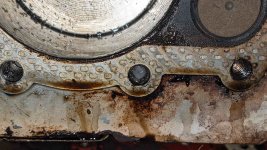
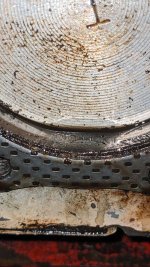
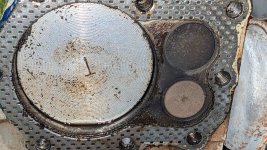
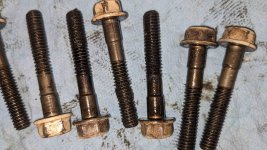
I inherited a 'Garden Way' sicklebar mower made in about 1980 along with a family property. I'm sure it's been ridden hard and put away wet in it's life.
After pulling the head and re-installing, when I had to pull it again, I found that there was a surprising amount of oil on the head bolts. When I looked further I found that there was some oil pooled on the bottom of the cylinder wall (this is a horizontal shaft engine). When I wiped that oil and turned it over 4 or 5 strokes with a wrench the oil returned. Wiped it again, blocked the machine so the cylinder wall was angled up at about 10 degrees, and then turned it over 4 or 5 strokes, and there was some oil on the cylinder wall, but not enough to pool.
I've never seen this much oil come through the rings before. I've never seen enough oil get through that it seems to coat the whole of (most of) the head bolts. Am I looking at something other than a ring job? Is this somewhat normal on a 40 year old horizontal shaft? This machine would be super useful to me, but it also would only be used about 20 hours a year on personal stuff.
More background:
I inherited this acerage, and it was abandoned for a while, and when I can get this mower to run it's very useful. The thing that kicked off this investigation is that when trying to start it I get finger breaking kickbacks. On the rare occasion it starts, it runs "fine". I quoted "fine" because it's governor controlled, and even with the speed lever set to 'ludicrous' speed, where the throttle control reaches a stop preventing the throttle adjust screw from opening further, it runs at only about 3000rpm. And it also only runs for about 30 min on a full tank of gas. I'd appreciate any comments on whether those are reasonable for this engine / application.
Thank you for taking the time to look at this guys. Would love to actually fix it.




#2
R
Rivets
R
Rivets
First thing I would check is a sheared or partially sheared flywheel key. This is the primary cause of kickbacks.
#3
G
gmcinnes
G
gmcinnes
Oh, forgot to mention that. I checked it. Looked totally fine. Replaced it anyway out of an abundance of caution.First thing I would check is a sheared or partially sheared flywheel key. This is the primary cause of kickbacks.
#4
R
Rivets
R
Rivets
I’m not trying to be an A%&$, but are you sure you torqued the flywheel nut property? Wouldn’t be the first time someone replaced it and forgot.
#5
G
gmcinnes
G
gmcinnes
Oh, all questions that assume I'm an idiot are welcomed. They're far from out of place. 
It doesn't have a flywheel nut as such. It has a clutch assembly that threads on and presses the flywheel on the shaft. But it's not really amenable to torquing. There isn't even a great way to get a wrench on it to tighten it. But I can get it on tight enough that it won't fly off, and that's enough to press the flywheel down on the conical shaft, and the key keeps it positioned correctly laterally. So I don't *think* there's a problem there.
Pics of clutch / flywheel / key below.
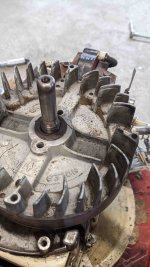
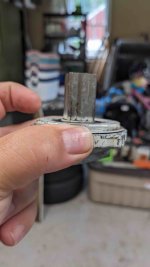
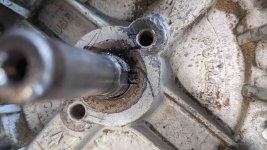
It doesn't have a flywheel nut as such. It has a clutch assembly that threads on and presses the flywheel on the shaft. But it's not really amenable to torquing. There isn't even a great way to get a wrench on it to tighten it. But I can get it on tight enough that it won't fly off, and that's enough to press the flywheel down on the conical shaft, and the key keeps it positioned correctly laterally. So I don't *think* there's a problem there.
Pics of clutch / flywheel / key below.



#6
R
Rivets
R
Rivets
More questions. When you installed the starter clutch, did you make sure the beveled washer was installed with the cup down? Did you check the coil air gap, should be .010”? Does you engine have points ? If it does, did you set the point gap to .020“? I fully understand that those starter clutches can be a beast to torque, especially if you don’t have a clutch tool, but if the washer was installed incorrectly or not torqued properly, the key will shear on the first pull. Here is a service manual which might come in handy. If you come back please include all engine numbers. http://www.tuks.nl/WFCProject/img/E...210-Briggs-Stratton-Service-Manual-L-Head.pdf
#7
G
gmcinnes
G
gmcinnes
Now... When you say bevelled washer... I don't think I have such a thing. Between the bottom face of the clutch and the top of the flywheel there is a flat washer. Am I misunderstanding? (See below for image).
I set the coil gap to .010" (I even used feeler gauges!)
No points on this engine.
Engine numbers are:
Model 114982
Type 0180-01
Code 85120504
B&S 4HP I/C Industrial
You can see the key from the top down shots in the pictures in my last post. Does the key look ok? I wondered at one point if the key is too narrow for the keyway, which looks a few thou too wide. But it seems to taper towards the bottom, so the key fits snugly.
The engine *does* run. Eventually. And badly. And only after trying to release my fingers from their prison on my hand.
What are your thoughts on the oil in the cylinder? Is that something that could be causing problems, or is it unrelated?
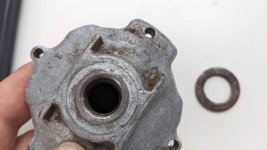
I set the coil gap to .010" (I even used feeler gauges!)
No points on this engine.
Engine numbers are:
Model 114982
Type 0180-01
Code 85120504
B&S 4HP I/C Industrial
You can see the key from the top down shots in the pictures in my last post. Does the key look ok? I wondered at one point if the key is too narrow for the keyway, which looks a few thou too wide. But it seems to taper towards the bottom, so the key fits snugly.
The engine *does* run. Eventually. And badly. And only after trying to release my fingers from their prison on my hand.
What are your thoughts on the oil in the cylinder? Is that something that could be causing problems, or is it unrelated?

#8
G
gmcinnes
G
gmcinnes
Oh! And thanks for the manual. I have an old B&S manual I've been going from that is probably from the early 80s. Yours is better.More questions. When you installed the starter clutch, did you make sure the beveled washer was installed with the cup down? Did you check the coil air gap, should be .010”? Does you engine have points ? If it does, did you set the point gap to .020“? I fully understand that those starter clutches can be a beast to torque, especially if you don’t have a clutch tool, but if the washer was installed incorrectly or not torqued properly, the key will shear on the first pull. Here is a service manual which might come in handy. If you come back please include all engine numbers. http://www.tuks.nl/WFCProject/img/E...210-Briggs-Stratton-Service-Manual-L-Head.pdf
#9
R
Rivets
R
Rivets
Engine was built in 1985. There should have been a washer, part number 691736, between the starter clutch and flywheel. You can really tell if a flywheel key is good or bad unless you remove it and make sure it is not starting to shear.
#10
G
gmcinnes
Using my fingernail I can feel it's slightly convex on one side and slightly concave on the other, but it's not visible to the (my) eye. In any case, I had the concave side down, facing the flywheel. Is that right?
I'll remove the flywheel again to inspect the key.
G
gmcinnes
There's a washer there. It looks like this one: https://shop.briggsandstratton.com/products/briggs-and-stratton-691736-washer from the part number you quoted. You can see it (out of focus) on one of the clutch pictures above.Engine was built in 1985. There should have been a washer, part number 691736, between the starter clutch and flywheel. You can really tell if a flywheel key is good or bad unless you remove it and make sure it is not starting to shear.
Using my fingernail I can feel it's slightly convex on one side and slightly concave on the other, but it's not visible to the (my) eye. In any case, I had the concave side down, facing the flywheel. Is that right?
I'll remove the flywheel again to inspect the key.
#12
B
bertsmobile1
B
bertsmobile1
Some call them cup washers, some call them bevel washers, what they are is a spring washer
If it has worn flat then it requires replacing
There is a B & S tool that sits over the clutch which has a hex end for a tension wrench
No one is trying to be insulting but as none of us have any idea about the mechanical competency of the posters then we assume they have never touched a mower in their life .
It is amazing how many people who have rebuilt dozens of car & truck engines can not work out mower engines and then there is elec-trickery
To go back to first principles the engine needs fuel at around 14:1 needs a spark a the right time and compression above 45 psi or it won't start and that needs to be 65psi or better at running speed or it won't stay running .
When left standing for a long while fuel and condensed water accumulates in the sump
Now am I safe to assume you drained the sump and refilled to the correct level with fresh oil ?
If it has worn flat then it requires replacing
There is a B & S tool that sits over the clutch which has a hex end for a tension wrench
No one is trying to be insulting but as none of us have any idea about the mechanical competency of the posters then we assume they have never touched a mower in their life .
It is amazing how many people who have rebuilt dozens of car & truck engines can not work out mower engines and then there is elec-trickery
To go back to first principles the engine needs fuel at around 14:1 needs a spark a the right time and compression above 45 psi or it won't start and that needs to be 65psi or better at running speed or it won't stay running .
When left standing for a long while fuel and condensed water accumulates in the sump
Now am I safe to assume you drained the sump and refilled to the correct level with fresh oil ?
#13
G
gmcinnes
 . I contribute on some other places and totally get it. In case it wasn't obvious I really *am* happy to get the 'duh..' questions.
. I contribute on some other places and totally get it. In case it wasn't obvious I really *am* happy to get the 'duh..' questions.
Case in point about 'duh...' questions. I absolutely did *not* replace with fresh oil yet, to my shame. I figured I'd splash out on the oil if I could get it to fire, but here we are, having had it run for about an hour all told, and I haven't replaced it. Will do that next.
G
gmcinnes
Interesting. What's the function of the spring washer, out of curiosity? Is it convex on top to further reduce friction between the clutch and the flywheel?Some call them cup washers, some call them bevel washers, what they are is a spring washer
If it has worn flat then it requires replacing
There is a B & S tool that sits over the clutch which has a hex end for a tension wrench
Absolutely. I like to think I know how to turn a wrench, but I'm well aware I don't know what I don't know, and have been humbled more than onceNo one is trying to be insulting but as none of us have any idea about the mechanical competency of the posters then we assume they have never touched a mower in their life .
It is amazing how many people who have rebuilt dozens of car & truck engines can not work out mower engines and then there is elec-trickery
To go back to first principles the engine needs fuel at around 14:1 needs a spark a the right time and compression above 45 psi or it won't start and that needs to be 65psi or better at running speed or it won't stay running .
When left standing for a long while fuel and condensed water accumulates in the sump
Now am I safe to assume you drained the sump and refilled to the correct level with fresh oil ?
Case in point about 'duh...' questions. I absolutely did *not* replace with fresh oil yet, to my shame. I figured I'd splash out on the oil if I could get it to fire, but here we are, having had it run for about an hour all told, and I haven't replaced it. Will do that next.
#14
G
gmcinnes
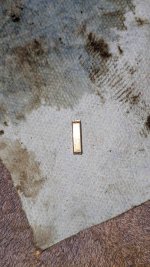
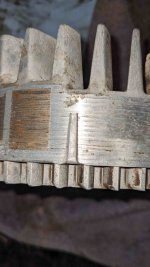
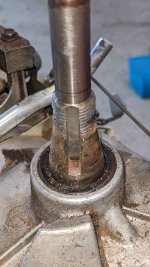
G
gmcinnes
Here's the key, along with the keyway in the flywheel and crank. It looks ok to me, but I have no experience.There's a washer there. It looks like this one: https://shop.briggsandstratton.com/products/briggs-and-stratton-691736-washer from the part number you quoted. You can see it (out of focus) on one of the clutch pictures above.
Using my fingernail I can feel it's slightly convex on one side and slightly concave on the other, but it's not visible to the (my) eye. In any case, I had the concave side down, facing the flywheel. Is that right?
I'll remove the flywheel again to inspect the key.



#15
B
bertsmobile1
B
bertsmobile1
For the piston to go all the way down there has to be enough air space under the piston to accomodate the compression volume
Yes I know there are breathers and on motors that have been sitting for a long time they often rust closed
On some of the motorcycles I own, when the contents of the oil tank end up in the sump you can not turn the engines over and if you do then you blow the crank case oil seals out .
Also things like mud wasps build nest is breather tubes which causes even more pressure to build up if you attempt to kick start them .
Yes I know there are breathers and on motors that have been sitting for a long time they often rust closed
On some of the motorcycles I own, when the contents of the oil tank end up in the sump you can not turn the engines over and if you do then you blow the crank case oil seals out .
Also things like mud wasps build nest is breather tubes which causes even more pressure to build up if you attempt to kick start them .
#16
G
gmcinnes
Following up gents:
Of all the things I tried it seems like the most important was this. After draining and re-filling the oil it starts on the 3rd or 4th pull. No kickbacks so far.
FWIW I was able to counter-hold the flywheel with a Harbor Freight strap wrench. I tightened the clutch with a chisel and a tap from a hammer. I'm not sure it's . I'm sure it's tight enough.
I still feel like it's running a bit slow, and a bit low power. I measured it, and it's running about 2900 rpm. The throttle lever is pinned against a stop, but the governor lever doesn't get pulled to where I think it should be. It could be that the spring that links them is weak. I'll try and figure it out, based on the great manual. I'll start a new thread if I can't figure it out.
Thanks guys.
G
gmcinnes
For the piston to go all the way down there has to be enough air space under the piston to accomodate the compression volume
Yes I know there are breathers and on motors that have been sitting for a long time they often rust closed
On some of the motorcycles I own, when the contents of the oil tank end up in the sump you can not turn the engines over and if you do then you blow the crank case oil seals out .
Also things like mud wasps build nest is breather tubes which causes even more pressure to build up if you attempt to kick start them .
Following up gents:
Of all the things I tried it seems like the most important was this. After draining and re-filling the oil it starts on the 3rd or 4th pull. No kickbacks so far.
FWIW I was able to counter-hold the flywheel with a Harbor Freight strap wrench. I tightened the clutch with a chisel and a tap from a hammer. I'm not sure it's . I'm sure it's tight enough.
I still feel like it's running a bit slow, and a bit low power. I measured it, and it's running about 2900 rpm. The throttle lever is pinned against a stop, but the governor lever doesn't get pulled to where I think it should be. It could be that the spring that links them is weak. I'll try and figure it out, based on the great manual. I'll start a new thread if I can't figure it out.
Thanks guys.
#17
R
Rivets
R
Rivets
Try adjusting the throttle control cable first. Loosen the cable clamp and with the throttle control push forward, push the cable as far forward as possible and tighten the clamp. Not uncommon for the clamp to come loose and move back.
#18
S
SmallEngineHead160
S
SmallEngineHead160
you can sometimes slightly bend the control lever tab that the spring hooks onto to make fine tune adjustments on these.
you could also tension the spring a little bit more by pulling the spring a little tighter and forming a new hook but this can
get messy real quick if not done carefully and often is to much of a step up in speed.
you could also tension the spring a little bit more by pulling the spring a little tighter and forming a new hook but this can
get messy real quick if not done carefully and often is to much of a step up in speed.
